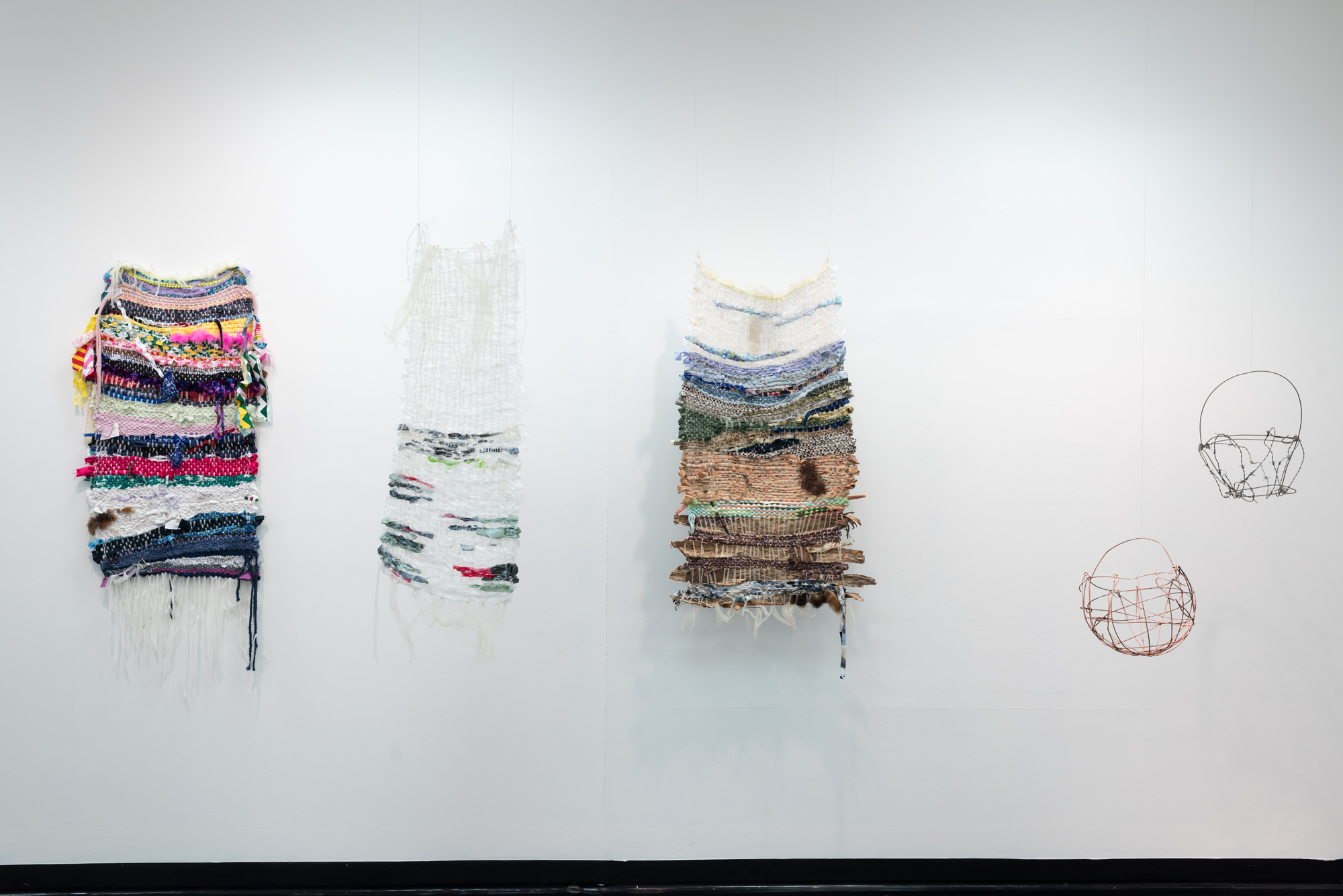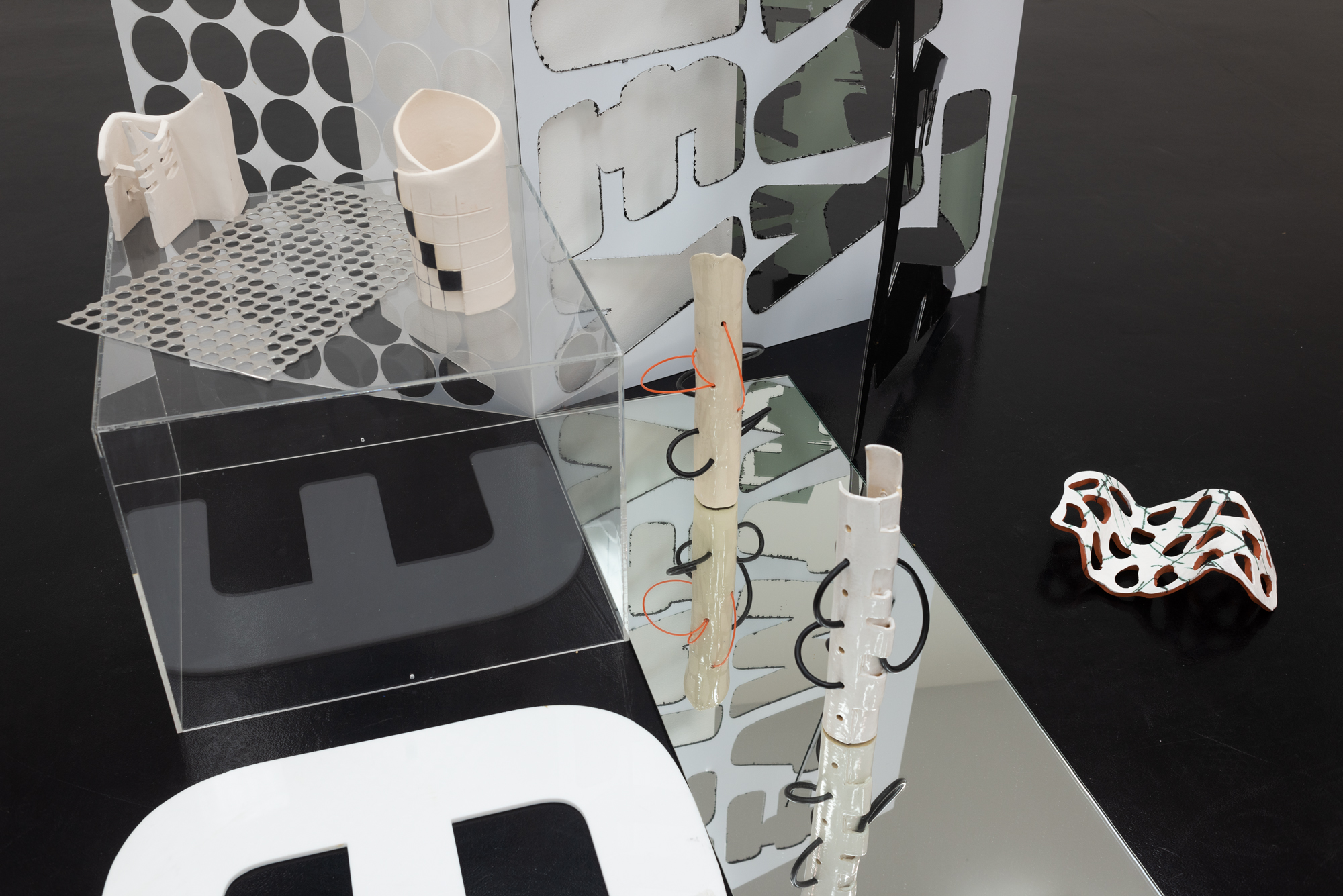Past exhibitions
Explore details of our past exhibitions from 2019. To view catalogues and details of La Trobe University Museum of Art (LUMA) exhibitions from 1970 until now, visit our Opal Repository.
18 Aug to 5 Nov 2023
Artists: Diana Baker Smith, Lorraine Connelly-Northey, Zoë Croggon, Dean Cross, Narelle Desmond, Emily Floyd, Inge King, Sriwhana Spong, Augusta Vinall Richardson
Curator: Amelia Wallin
This exhibition takes as its point of departure Dialogue of circles by Inge King (1915–2016), a singular work in the La Trobe University Art Collection. King’s site-specific steel sculpture is situated within the moat at the Melbourne (Bundoora) Campus, just south of its centre, the Agora. Since its installation in 1976, the work has functioned as both landmark and backdrop for public gatherings and performances in the Moat Theatre.
The exhibition Circles of dialogue invites a gathering of contemporary artistic responses that centre the body, as a container of memories and experiences, in relation to monumental works of public art and their materialist histories. The artworks on display respond to the dynamic spirit of King’s sculptures from the 1970s, which were intended to mediate between the body of the viewer and the surrounding environment. The exhibition enfolds King’s modernist legacy into a broader dialogue that encompasses First Nations and colonial memory, material conservation and bodily archives.
The exhibition inverts King’s original title, opening an exchange on geometric form and grammar and proposing new perspectives, conversations and interpretation. King, a European postwar migrant, teacher and member of the artist group Centre Five, is renowned for her formal sculptures across public spaces in Melbourne. She is one of few female artists in an art form dominated by men. King’s influence can be traced through the practice of contemporary artists such as, in this exhibition, Emily Floyd and Augusta Vinall Richardson.
Read more about the exhibition and the artists in the exhibition guide [PDF 1.3MB] and the list of works [PDF 106KB]
Biannual Façade Commission
1 Aug 2023 to 4 Feb 2024
Curator: Amelia Wallin
Working with media as diverse as photography, sculpture, scent and food, artist James Tylor draws from his Nunga (Kaurna Miyurna), Māori (Te Arawa), Anglo-Celtic, Dutch and Norwegian ancestry to explore Indigenous and colonial histories. Through artworks grounded in knowledge of the past, Tylor explores the continuous effects of 19th-century Australian colonial practices on our cultural identity and environment.
For his commission, Tylor has revisited a trope from an earlier series titled (Deleted scenes) From an untouched landscape (2013). In this series, geometric shapes dominate the foreground of black-and-white photographs of landscapes. Alternately rectangular, square and circular, the shapes are affronting in their incongruity against photographs of empty fields, rolling hills or rugged coastlines. Each image is notable for the absence of people. Tylor disrupts the surface of his digital images through physical intervention, by cutting and positioning a given shape. For this commission, a rectangle has been physically cut from the adhesive vinyl that covers the glass. On the reverse side of the glass, black vinyl deepens the sense of erasure.
For Tylor, these black voids highlight the absence of Australian Aboriginal culture in the contemporary landscape as a direct impact of colonisation. The first British and European colonisers systematically dismantled the sites and tools of Aboriginal cultural and agricultural practices. Aboriginal peoples were displaced, moved off their traditional lands and into small Christian missions and government reserves. The landscape and its inhabitants were cleared, paving the way for European settlements, forestry and farming practices. Tylor has stated:
'This clearing of the landscape resulted in the removal of Indigenous cultural artifacts and our identity from the Australian landscape ... This has left much of the Australian landscape with the appearance that it was "untouched" before European arrival.'
The mythology of a rugged and pristine Australian landscape is a colonial construct. James Tylor draws our attention to the unique continuum of Aboriginal culture despite attempts at eradication.
Image: James Tylor, From an untouched landscape, 2023, digital photograph on adhesive vinyl, 430 x 740 cm. © James Tylor. Courtesy the artist
16 May to 5 Aug 2023
Artists: Darcey Bella Arnold, Betty Chimney and Raylene Walatinna, Calista Lyon and Carmen Winant, Noriko Nakamura, Jahnne Pasco-White, Nina Sanadze and Yhonnie Scarce
Curator: Amelia Wallin
Maternal inheritances is an exhibition of Australian and international artists that explores the entanglements of motherhood and matriarchy with ideas of genealogy, influence and impact.
The term ‘maternal inheritance’ refers to a biological phenomenon whereby mitochondrial DNA is transferred from mother to offspring. Despite being present in most multicellular organisms, the fact that mitochondrial DNA only contains maternal DNA continues to elude biologists. It is this phenomenon that enables the popular at-home ancestry kits, where a sample of saliva can trace maternal DNA to help us better understand our ancestral lineage.
Maternal inheritances takes this biological occurrence as a starting point to develop an expanded understanding of the maternal that includes other experiences of kin-making. It proposes maternal inheritance as a state of entanglement that produces multiple, complex relations to and with the world. It expresses these positions through a range of artistic responses across disciplines and between generations.
The exhibition presents artworks – sculpture, painting, multi-channel video and installation – that address Country and matrilineality, material and ancestral inheritance, anthropogenic catastrophies and intergenerational trauma.
For the artists, ideas about maternal inheritance are linked to non-linear understandings of time and complex relations to memory, materials and motherhood. In this way, the exhibition is multidirectional; the artists look back at previous generations to glean knowledge, understanding of histories and a sense of self and identity, while contemplating the future.
As we face climate emergencies of catastrophic proportions, to say that the future feels uncertain is an understatement. Yet the concept of inheritance, be it material or ancestral, is quietly optimistic. The notion of inheritance assumes that there are still resources – indeed, a future – to inherit. In drawing parallels between reproductive and ecological care, this exhibition invites artists and audiences to navigate and reflect on maternal inheritance both as a state of precarity and an optimistic blueprint for our future.
Read more about the exhibition and the artists in the exhibition guide [PDF 223KB]
Image: Noriko Nakamura, Womb realm, 2022, limestone; McClelland Sculpture Park and Gallery. © Noriko Nakamura. Courtesy the artist. Photo: Christian Capurro
Biannual Façade Commission
16 Mar to 30 July 2023
'The throttled Earth – the scalped, the mined, the industrially farmed, the drilled, polluted, and suctioned land, endlessly manipulated for further development and profit – is now our home … we ask, many of us, what will the next step be?'
– Barry Lopez, Horizon, 2019
Memory and resistance are motivating forces for artist Calista Lyon, who was raised in the agricultural community of Tallangatta Valley in north-eastern Victoria and now lives in Columbus, Ohio. Through a practice that incorporates photography, collage and archival imagery, Lyon seeks to understand the past to make amends for our collective futures. She asks, ‘How can our love for a place be a position to begin an unlearning and relearning?’
Lyon’s recent work, made in collaboration with community members, scientists, amateur botanists and historians, exposes the effects of extraction and capital accumulation on local ecologies. Her specific focus is the box-ironbark forest, an Indigenous forest which spans the colonial settlement of Victoria, including the Bendigo region. Now considered one of the most endangered habitats in Australia, this ecosystem has been denuded by tree felling, soil extraction and water degredation, beginning with settler agricultural practices in the 1830s and intensifing during the gold rush of the 1850s.
For our new site-specific commission, Lyon uses photographic collage techniques to map the ecological impact of gold mining. She draws her imagery, both historical and contemporary, from the Bendigo Goldfields region. Elements such as drone footage of a local mine currently in operation and images of her own laptop and her mother’s engagement ring remind us that mineral extraction continues today with wide-ranging uses in society.
During the Victorian gold rush, artificial channels diverted huge amounts of water from local river systems to aid in the extraction of gold. Lyon collages archival imagery to remap these water races, which appear like veins running across the artwork. Heaped at the base of the image are photographs of extracted soil that has been churned, blasted and displaced through mining.
Lyon’s large-scale artwork attends to overlooked details. Colonial drawings and photographs of felled trees are positioned adjacent to tightly cropped photographs of hands, enlarged to life-size proportions. These are the hands of gold miners, posing for photographic portraits. Lyon draws our attention not only to the hands of the labourer, but to the hands of the researcher – in this case, Lyon herself – and her active role in the selection, intervention and recording of histories.
Image: Calista Lyon, Remembering future (detail), 2023, including images sourced from the State Library of Victoria, National Library of Australia, Environment Protection Authority Victoria, Andrew F Bennett and Jocelyn Lyon; digital photograph on adhesive vinyl, 430 x 740 cm. © Calista Lyon. Courtesy the artist
14 Feb to 7 May 2023
Artists: Martha Atienza, Jonathan Baldock, Kait James, Helen Johnson, Nick Modrzewski, Jack Ky Tan and the Victorian Bar
Guest curators: Nick Modrzewski and Jack Ky Tan
This exhibition explores the idea of homo sacer (literally, 'sacred man'). Homo sacer is an ancient Roman legal idea that a person who has been removed from and placed out of the law and society, or from whom law has been withdrawn, could be killed without consequence. Through a group of sculptures, paintings and video artworks, the Homo sacer: life unlawed exhibition demonstrates how the law is not only embedded in (our) bodies, but creates the particular sense of material and social reality that we perceive in the everyday world.
The exhibition explores a range of entanglements: between art and politics, between the individual and the institution, between humans and non-humans, between the law and the body and between ritual and rules. In doing so, the law is revealed as a messy and visceral bundle of contradictions that regulates our ideas of inside–outside, validity–invalidity, belonging–rejection. The exhibition demonstrates ways in which the abject is an affect of legal withdrawal.
Homo sacer is curated by Jack Ky Tan and Nick Modrzewski, two artists with legal backgrounds who also make work at the intersection of art and law. The idea for this exhibition emerged from Zoom conversations between Tan and Modrzewski over a two-year period as a self-organised digital residency. The two artists roved through ideas of a ‘shadow world’ of law that underpins society, explored the legal rights of rivers and trees, visited the many faces or masks through which law is performed and unpicked the symbolic rituals of legal processes. It is through this experience that they developed a shared philosophical and aesthetic understanding of the law that they now draw on to bring together a diverse group of artists for Homo sacer.
For Nick Modrzewski, this exhibition brings together four years of artistic and legal research. Practising as both a barrister and an artist, Modrzewski’s daily life is deeply entangled with the law. The questions and experiences he encounters in his professional life are filtered into his art practice, emerging as densely layered paintings where he depicts figures enmeshed in legal processes or bureaucratic systems: naked neighbours wrestle over a fencing dispute, a congregation of medieval noses gathers to draft legislation and mortgage brokers sing songs about home loans. In each of his ‘scenes’, Modrzewski picks apart the rules of social engagements, rendering them in a sensuous and fluid painterly language or in sculptures, texts and performances.
Jack Ky Tan uses law as medium in his artistic practice, approaching the law itself as if it were a form of clay or objet trouvé that he sculpts or assembles with other elements. Tan uses existing law in new ways and speculates on futurist applications of law or policy. For example, he created a karaoke court whereby ‘litigants’ resolved their disputes via karaoke singing before an audience-jury under binding arbitration contracts. He also revived the medieval animal trials (where accused animals were represented in court and tried for crimes) as a fully functioning modern court of law in order to imagine a possible more-than-human legal system. In this way, Tan’s work brings together legal research and drafting, socially engaged practice and art installation to create immersive experiences of law. Being a queer, migrant, global majority artist who lives or has lived under colonial sodomy laws, racialised immigration laws and the eroding human rights and equality legislation in the UK, the law has shaped Tan’s history and continues to inform his practice today.
Read more about the exhibition and the artists in the exhibition guide [PDF 154KB] and the list of works [PDF 72KB]
Biannual Façade Commission
Borchardt Library on Bundoora Campus
27 Feb to 25 July 2024
View Street Façade
3 Sept 2022 to 12 Mar 2023
Curator: Amelia Wallin
This new public art commission by artist and poet Chunxiao Qu presents four short poems on our building’s façade. Through illumination and upscaling, Qu has transformed her poems from intimate observations recorded on her iPhone Notes app into street signs. Composed in English and then translated into Mandarin, the poems have their origins in Qu’s experience of existing between dual cultures and languages.
Writing in her non-native tongue, Qu approaches the English language as found material. She interrogates English words and phrases and their translations to better understand their meaning. In what she calls her ‘logic poetry’, Qu rearranges the principles and systems of the English language to expose absurdities in our everyday usage. ‘Even when I myself read them, I have to spend some time to figure out if they are right’, she comments.
The visual effect of Qu’s colourful, illuminated lettering recalls the visual language of advertising, especially the luminous signs associated with urban sprawl and late-night entertainment. Qu also references the lineage of text art, specifically the use of glass neon to materialise words and phrases characteristic of 1960s conceptual art. But rather than traditional electrified glass tubes, Qu uses LED neon tube lights to achieve the same effect.
Qu’s quip that ‘genius don’t need to work hard’ echoes conceptualism’s emphasis on ideas over technical skill, while at the same time dismantling the myth of the individual genius that has come to define twentieth-century narratives of art. Like her use of the more accessible and economical LED, Qu democratises conceptual art, taking it from gallery walls to the heart of Bendigo's arts precinct, visible to everyone.
On View Street, Chunxiao Qu’s four poems reflect on art, Western culture, language and translation. For the first time, she has included Chinese translations alongside her English poems. The effect is a bilingual meditation on difference, loneliness and community created by an outsider to Australia’s de facto national language.
Chunxiao Qu (born Qingdao, China, 1993) is an artist and poet who lives and works in Melbourne (Wurundjeri Woiwurrung and Boonwurrung Country). She is the author of two books of poetry and has exhibited in solo and group exhibitions in Melbourne and internationally. An artist doesn’t need a label is her first large-scale public artwork, as well as her first in a public institution.
25 Oct 2022 to 5 Feb 2023
Artists: Anna Daučíková, Luke Fowler, Gail Hastings, Rita Keegan and pieces from the Etta Hirsh Ceramics Collection, with exhibition design in collaboration with Maud Vervenne
Guest curator: Isabelle Sully
Citational choices takes La Trobe University’s Etta Hirsh collection of ceramics as its point of departure. The exhibition will combine the Hirsh Collection – amassed between the late 1960s and the 1990s – with artwork by contemporary artists. Like the precious ceramic vessels that Hirsh used in her home and everyday life, Citational choices marries the functional and the formal. The exhibition combines ceramics with archival material, moving image, sculpture, exhibition design and publishing. Together, these elements unravel the biographical stories present within the collection itself – those of Etta Hirsh, of a local art scene, of La Trobe Art Institute and now, in the case of this exhibition, everyone newly involved. Through contemporary works which engage with personal and material archives, the exhibition pays particular attention to the biographical stories – the anecdotal and the informal ones – that don’t often make it onto the record.
Read Isabelle Sully’s curatorial statement below.
"The Etta Hirsh Ceramics Collection is an eclectic array of ceramic artworks produced by Australian artists between the early 1960s and late 1990s, donated in avid collector Etta Hirsh’s name to La Trobe University between 2009 and 2011. The collection, in a careful compulsion towards conservation, remains largely in storage. Yet when Etta Hirsh began collecting ceramics in the 1950s, she never intended for them to become static. Instead she used them in her everyday life, maintaining their function while also appreciating them all the more through living with them so intimately. Such a decision leaves intriguing material traces throughout the collection; chips to the ceramic surfaces and other signs of wear convey Hirsh’s insistence that the essence of the artwork is felt when it is touched and engaged with.
The personal nature of the Etta Hirsh Ceramics Collection stands as a biography of sorts, though it is an intertwining biography: of an individual, a community in the form of the local art scene that the collection encompasses and of an institution in La Trobe Art Institute (and its predecessors, such as La Trobe University Museum of Art). Citational choices is therefore an attempt to flesh out the footnotes of these intersecting biographical stories, the ones that slip through the cracks of archival and administrative processes, or which simply do not translate, and to ensure that in one way or another, these instances make it on to the record.
To assist in this process and to add another layer of citation, a number of contemporary artists will present work alongside pieces from the Etta Hirsh Collection. These are works which engage with the institutional university setting, with (family) history and its material relics, and with space and its organising principles; much like the different factors that come together to maintain a collection in the first place."
– Isabelle Sully, August 2022
Read more about the exhibition and the artists in the exhibition guide [PDF 340KB] and the list of works [PDF 78KB]
14 July to 16 October 2022
Artists: Tiyan Baker, Jenna Lee, Cindy Lien, NC Qin, Renee So, Jia Sung, Louise Zhang
Guest curator: Sophia Cai
Personal mythologies explores the role that fantasy and imagination play in our constructions of self and our relationships to place and history. This thematic group exhibition brings together sculpture, installation, photography, textiles and painting by seven Australian and international artists. These works address elements of folklore, mythology and storytelling, complicating ideas about cultural expression and translation.
For Cai, Personal mythologies is, at its heart, a diasporic and transcultural exhibition that investigates what it means to relate to the broader Asian continent from afar. It is a project that considers complex notions of personal identity, how we forge and maintain connections and what new meanings can arise from these encounters.
This exhibition has been developed to complement the exhibition In our time: four decades of art from China and beyond – the Geoff Raby Collection co-presented with Bendigo Art Gallery (20 August 2022 to 19 February 2023).
Read more about the exhibition and the artists in the exhibition guide [PDF 220KB]
Image: NC Qin, Glass armour, 2020 (development ongoing), cast glass (Blackwoods lead crystal), marble, brass. © NC Qin. Courtesy the artist
8 March to 11 Sept 2022
Artist Dean Cross excavates the forgotten, the misinterpreted and the misremembered. He uncovers the lesser-known histories that challenge broader colonial and cultural narratives. In this public artwork, Cross turns his attention to Greater Bendigo, a region built on the extraction of gold and, later, clay.
Bendigo is the hometown of Francis Gerald (Frank) McEncroe, a boilermaker who is remembered as the creator of the chiko roll. Remaking the East Asian spring roll as a large snack sturdy enough to eat one-handed, McEncroe’s chiko roll has been ubiquitous in Australian fast-food shops and supermarkets since the 1960s. For Cross, the rise of the chiko roll encapsulates the forces of capitalism, cultural appropriation and extraction that have been at play in this country since settler colonisation.
Written in Cross’s own hand, a list of ingredients first reads as an heirloom family recipe. Continue reading, however, and familiar foods are supplemented with additives and emulsifiers. These are the ingredients of the industrialised chiko roll, mass-produced to taste exactly the same, regardless of where it was made.
Nothing lasts forever overlays this text with an image of a native hopping mouse and, faintly, a field of daisies. Indigenous to Australia, these species have been ostracised or misunderstood due to associations with introduced varieties and settler agricultural practices. Cross’s artwork links ‘big ag’ and industrialised food production to the erosion of native food systems and the changing landscape.
The title of the work, like the barely-there daisies pushing through, is quietly optimistic. If nothing lasts forever, if our current systems of industrialised farming give way, what new methods of renewal and reproduction might we imagine?
29 March to 3 July 2022
Artists: Colleen Ahern, Rebecca Baumann, Priyageetha Dia, Eng Kai Er, Lou Hubbard, Michelle Mantsio, Melati Suryodarmo
Guest curator: Amita Kirpalani
Attention seeker explores how visual artists take inspiration from the choreography, artifice and charisma of iconic performances by musicians and actors. Through painting, sculpture and video works by seven international and Australian artists, the exhibition examines performances as planned events that can come unstuck or deviate from the rehearsal. It looks at performers caught in the act or between the lines and reveals unpredictable staging, unruly costumes, slips of the tongue or actual slips.
Throughout the exhibition, the artists are duetting with inanimate objects – a dinosaur costume, a golden curtain, an assembly of chairs, moveable tapestries, sticks of butter – and making them perform. Their work addresses the image of the idealised performer getting it ‘right’ as well as the way the performer connects with an audience through practice, repetition and authenticity. Attention seeker invites us to ask how charisma translates across stage, screen and sound. How does it carry through movement and gesture? And how, as audience members, is our attention demanded? Where does it belong?
This exhibition has been developed to complement Bendigo Art Gallery’s exhibition, Elvis: Direct from Graceland. Where Elvis examines a singular iconic performer, Attention seeker brings together works that unpack the risk, structure and release of a performer standing in front of a real or imagined audience.
Read more about the exhibition and the artists in the exhibition guide [PDF 212KB]
Image: Colleen Ahern, paintings 2016–22 (left) and Rebecca Baumann, Untitled cascade, 2012–22 (right), tinsel curtain, electric fan; La Trobe Art Institute. © Colleen Ahern and Rebecca Baumann. Courtesy the artists. Photo: Leon Schoots
4 October 2021 to 25 April 2022
Every day we walk among residues of the past. Along Bendigo Creek, an observant walker will encounter traces of a time that predates colonisation, mining and urban development. Artists Kylie Banyard and Jessie Boylan spent time visiting Bendigo Creek during winter and early spring 2021. Rising gently about here is the result of their collaborative experiments with historical and contemporary photographs, maps, topographical drawings, oil paint and watercolour.
For thousands of years prior to European colonisation, Bendigo Creek flourished under Djaara custodianship. The oral traditions of the Dja Dja Wurrung People describe a healthy series of interconnected waterholes surrounded by wooded areas and treeless flats.
A map created by miner William Sandbach in 1851 describes the rhythms of the landscape as ‘sloping gently to the creek’ and ‘rising gently about here’. Such records inadvertently reveal the successful management of the creek by Djaara. Looking towards the city centre from the top of View Street we can imagine water pooling in the valley at the bottom of the hill, now paved in bluestone and hidden beneath the Alexandra Fountain.
In Rising gently about here, we see – and hear – a section of the creek north of Bendigo, where the waterway breaks out of the heavily engineered drain that runs through the city into a more naturalised, grassy bank just before the township of Huntly. As visitors on Country, Banyard and Boylan have made a speculative work that evokes the histories of the creek, its current state and its potential future.
2 August to 18 October 2021
Artists: David Attwood, Moorina Bonini, Sam Leach, Marian Tubbs
Curated by Kent Wilson
The works presented in this exhibition consider both the content of flooding data and the context of systems of delivery. They reflect on art’s role in the invention, maintenance and critique of our contemporary circumstances. Algorithms (in the work of Sam Leach), cultural knowledge (in Moorina Bonini’s panoramic printed image) and the excesses of our contemporary economy (in David Attwood’s assemblages and Marian Tubbs’ composite images and videos) invite us to consider how information is generated and distributed, and how our society communicates with itself.
David Attwood uses popular consumer items as iconographic tools, playing poetry with assembled phrasings of products. Through appropriating methods of presentation and display, Attwood’s readymades and sculptural works highlight the ways products are used to signal consumers’ value systems.
During Victoria's long COVID lockdown in 2020, Yorta Yorta and Wurundjeri-Woiwurrung woman Moorina Bonini spent time around the fire in her backyard learning how to work with biyula (red gum tree) to make small coolamons. For Bonini, the bark shavings produced as she sat deepening her learning through practice represent the stories passed down from her ancestors.
Marian Tubbs brings kaleidoscopic ‘ecologies’ of data together in hybridised collages of images and objects. An overflow of colour, pattern and form tumble forward in a vibrant escalation, holding a delicate balance as the imminent horizon of entropic collapse rushes to disrupt it.
Sam Leach has supplanted ‘individual’ choice with an artificial intelligence program to determine the imagery in his paintings. Using a combination of his own selected images and custom algorithms that ‘digest’ his entire body of work, the AI software ‘suggests’ the image he is most likely to produce next.
27 April to 18 July 2021
Artists: Bernard Boles, John Brack, Michael Chavez, Michael Cook, Simon Finn, Stephen Haley, Jian Jun Xi, Bea Maddock, Kristin McIver, Narinda Reeders, Naomie Sunner, Rose Wong
All that is solid is an exhibition of paintings, photographs, prints, drawings and sculptures that comment on ideas of institutional power. Spanning six decades, these works invite us to reflect upon the power dynamics embedded in political, social and economic systems.
The exhibition looks at a range of contexts and ways in which expressions of power are manifested. Works by Australian artists Mike Chavez, Narinda Reeders, Naomie Sunner and Bernard Boles investigate educational order, corporate office settings and political iconography respectively. A number of works in the exhibition ask us to consider the ways bodies engage with architecture in the context of an implied or explicit authority, as in Stephen Haley’s Vanishing point, Bea Maddock’s Flag or Jian Jun Xi’s Kiss earth, a smaller than life-size sculpture of a figure lying face down, perhaps depicting an act of submission or subversive resistance.
Some of the works challenge our assumptions or propose new perspectives on institutional contexts. Others offer metaphorical interpretations of loaded or absent forces, as in Simon Finn’s Reveal and Conceal, or Michael Cook’s Through my eyes, which asks how First Nations leadership would change Australia’s political landscape.
Gallery exhibition: 27 January to 18 April 2021
Facade commission: 16 February to 27 June 2021
A major new series of work by Australian photographer Danica Chappell titled Far From the Eye is being presented across the spaces of La Trobe Art Institute, Bendigo. Drawing from a collaborative dialogue with chemical biologist Dr Donna Whelan from La Trobe University’s Institute of Molecular Science, Chappell presents captivating and innovative artworks.
She describes her work as a collision of light, shadow, form, colour and actions into ‘apparitions of delectation’. Her work responds to the very nature of the papers, chemicals and processes of photographic production, blending traditional methods dating back to the earliest days of the medium with the most contemporary methods incorporating innovative technologies and materials.
Danica Chappell is a visual artist, creating on the traditional lands of the Boon Wurrung and Wurundjeri peoples, in Naarm (Melbourne). Through a darkroom practice, she explores abstraction and addresses the history of photography. Her work is based on shadows activated by the photogram – a process not requiring a camera – taking advantage of the flexibility of photographic processes. Light and shadow, form and colour collide, like apparitions responding to material in the act of becoming fixed into image.
13 January to 8 February 2020
A selection of artworks made using a simple algorithm rather than made by human choice and considerations of beauty, significance, concept, content or medium. Data criteria based on record keeping, such as alphabetical order of artist and date of acquisition into the Collections, has been used to select the works for display. Most items have come from long-term storage, some from campus display and one work cannot be exhibited as it is on long-term loan to another museum. Eliminating human subjectivity in choice allows for the aesthetic quality of the Collections as a system in its own right to emerge.
17 February to 28 March 2020
They Cannot Take the Sky: Stories from Detention is an exhibition of personal stories from people who have sought asylum in Australia and have been detained by the Australian government under its mandatory detention policy.
Through personal perspectives, explore one of the most complex issues of our time. The people you will meet in the exhibition are diverse and individual, their experiences are unique and often surprising.
You will hear about the reasons people flee their homes, their perilous journeys in search of safety, the banality of daily life in detention, and the afterlives - both lived and hoped for - of people resettling in Australia.
Stories from Detention was originally developed by Behind the Wire and a volunteer reference committee of individuals with lived experience of seeking asylum, in collaboration with Melbourne’s Immigration Museum. The regional tour of Stories from Detention is being co-presented by Behind the Wire and Road to Refuge.
Behind the Wire is an award-winning oral history project documenting stories from detention. Road to Refuge is a not-for-profit organisation that has been providing platforms for refugee voices in their words and on their terms since 2012. They aim to change the conversation on seeking refuge and asylum in Australia, by centring the art and stories of people with lived experience, and sharing them with broad audiences.
February 2020
Jacqueline Aust, Julie Barratt, AI Bell, Pauline Bellamy, Kathy Boyle, Glennys Briggs & Jenny Sanzaro-Nishimura, Diana Orinda Burns, Loris Button, Veronica Calarco, Blair Coffey, Carolyn Craig, Paul Croft, Stuart Evans, David Ferry, Robyn Gibson Mark Graver, Christopher Hagen, Toni Hartill, Wuon Gean Ho, Domenica Hoare, Mary Lloyd Jones, Kim Lowe, Anne Langdon, Kir Larwill, Alison Lochhead, Prue MacDougall, Jude Macklin, Tim Mosely, The NightLadder collective, (John Doyle, Angela Gardner, Maren Götzmann, Lisa Pullen & Gwenn Tasker), James Pasakos, Jan Palethorpe, Penny Peckham, Ian Phillips, Catherine Pilgrim, Melissa Proposch, Jude Roberts, Jenny Rock, Jennifer Stuerzl, Lynn Taylor, Gini Wade.
The exhibition was curated by Jude Macklin as part of the Australian Research Council project, ‘Rivers of Gold: the legacy of historical gold mining for Victoria’s rivers 2017–2020’, led by Professor Susan Lawrence (La Trobe University) and Mark Macklin (University of Lincoln).
The exhibition featured the work of forty artists from Australia, New Zealand and the UK, who took part in an international print exchange where they created a print that reflected on the legacies of gold mining in their respective regions.
July 27 to September 4 2020
Re-emerging from lockdown to engage with audiences and assert LAI’s dynamic participation in the cultural life of its communities, Tomorrow Never Knows presents a suite of works from the University Collections that evoke thoughts and feelings about the future. Challenging audiences to reconsider expectations about what the future holds, Tomorrow Never Knows explores ways in which art looks ahead in time to imagine where society and the environment made be headed, or reflects on how our hopes and fears from the past have played out.
14 January – 23 February 2019
Raymond Arnold, Ros Atkins, GW Bot, eX de Medici, Sonja Hodge, Ellis Hutch, Michael Kempson, Martin King, Mor Mor, Brian Robinson, Ian Westcott
This major exhibition travelling out of the second Australian Print Triennial is the culmination of a project that brought together nationally renowed landscape artists to respond to the rich natural and cultural environment of Mungo National Park, Willandra Lakes Region World Heritage Area.
Installation images by Ian Hill, 2019


11 March – 20 April 2019
Posters from La Trobe University's Stuart Fraser Poster Collection, graphic design, public health and activism.

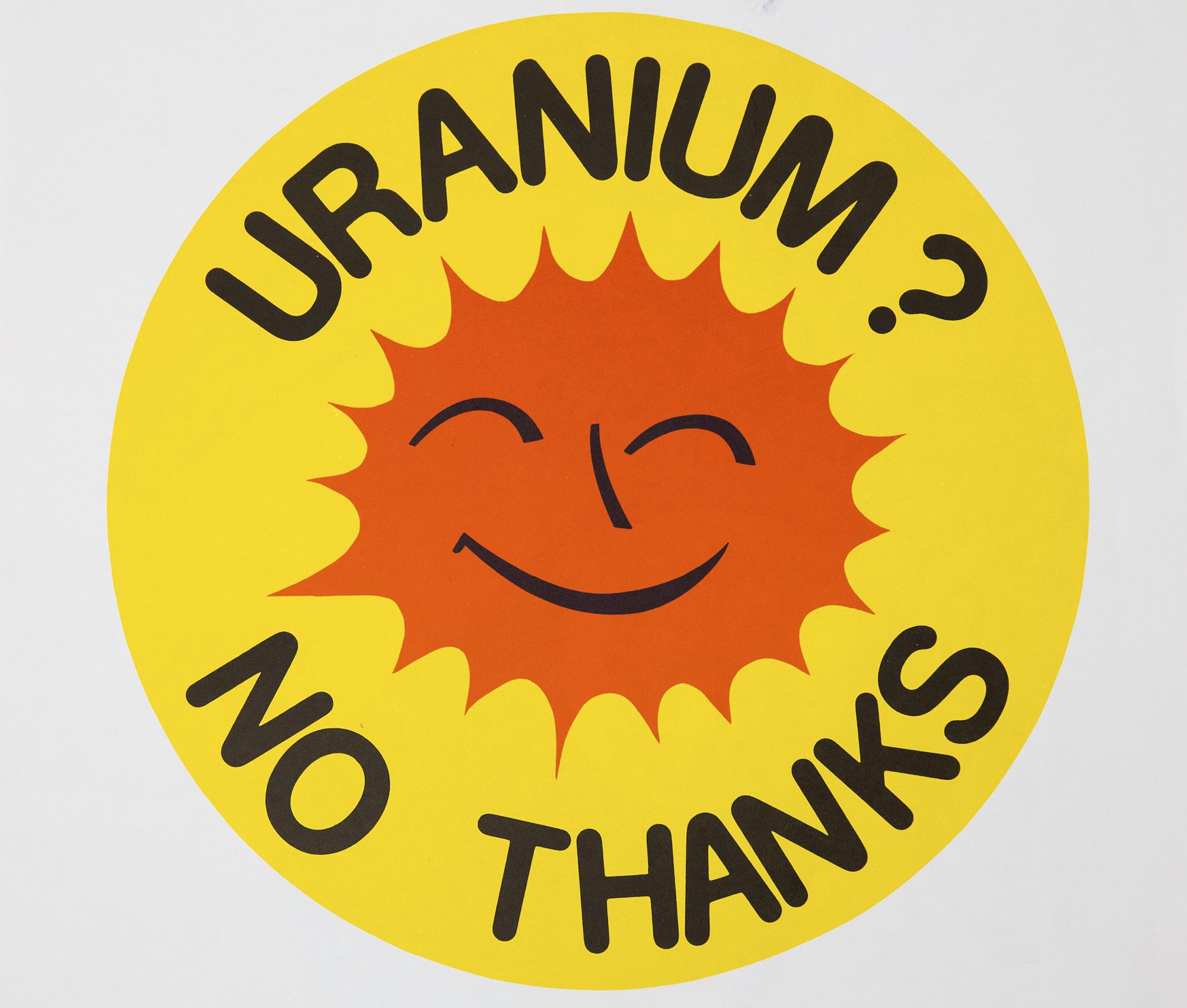

22 March – 31 March 2019
Abdul-Rahman Abdullah + Anna Louise Richardson, Cameron Robbins, Cyrus Tang, Dale Cox, Damien Shen + Robert Hague, Eliza Jane Gilchrist, Fayen d'Evie, Hayley Millar-Baker + James Tylor, Hayley West, James Carey, Jazoo Yang, Jemila MacEwan, Justin Andrews, Kay Abude, Kylie Stillman, Lyndell Brown + Charles Green, La Trobe University Art School - Jessica Murtagh, Paul Northam, Emidio Puglielli, Pie Rankine, Sue Ronco, Genevieve Thornton, Melinda Harper, Michael Graeve, Michael Wolfe, Sara Morawetz, Sisters Akousmatica, Susie Elliot + Helen Martin, Taichi Nakamura, Woven Dialogue
Image 1: Justin Andrews, Lissajous, 2019, exterior water-based paint on wall, 561.5 x 766.7cm. Courtesy of the artist and Blockprojects Gallery, Melbourne. Castlemaine State Festival 2019. Photo: Ian Hill.
Image 2: Hayley Millar Baker and James Tylor,Dark Country installation view, Castlemaine State Festival 2019. Photo: Ian Hill.
Image 3: Cameron Robbins delivering artist talk, Castlemaine State Festival 2019.
Image 4: Fayen d’Evie, From Dust to Dustinstallation view, Castlemaine State Festival 2019. Photo: Ian Hill.
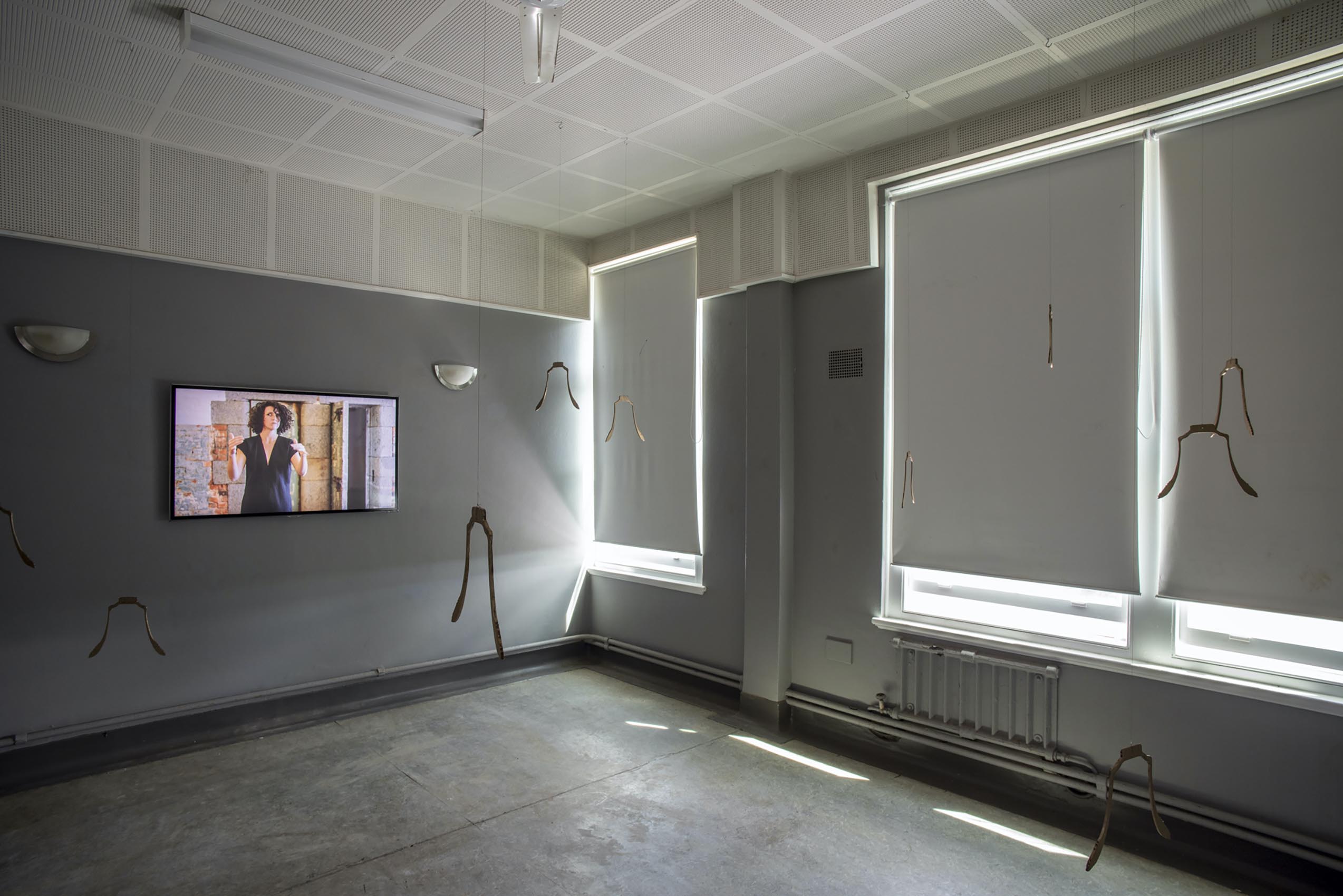
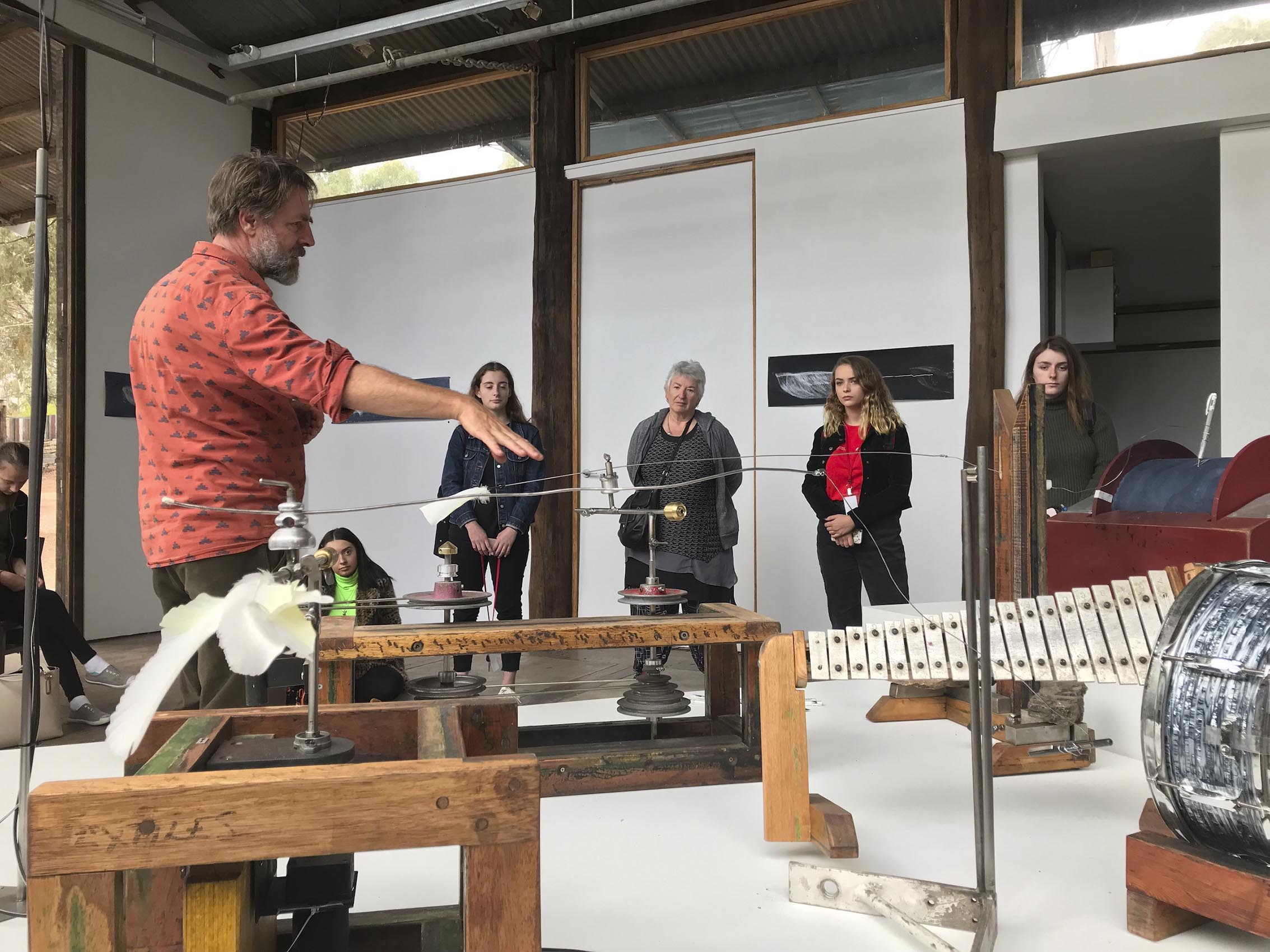
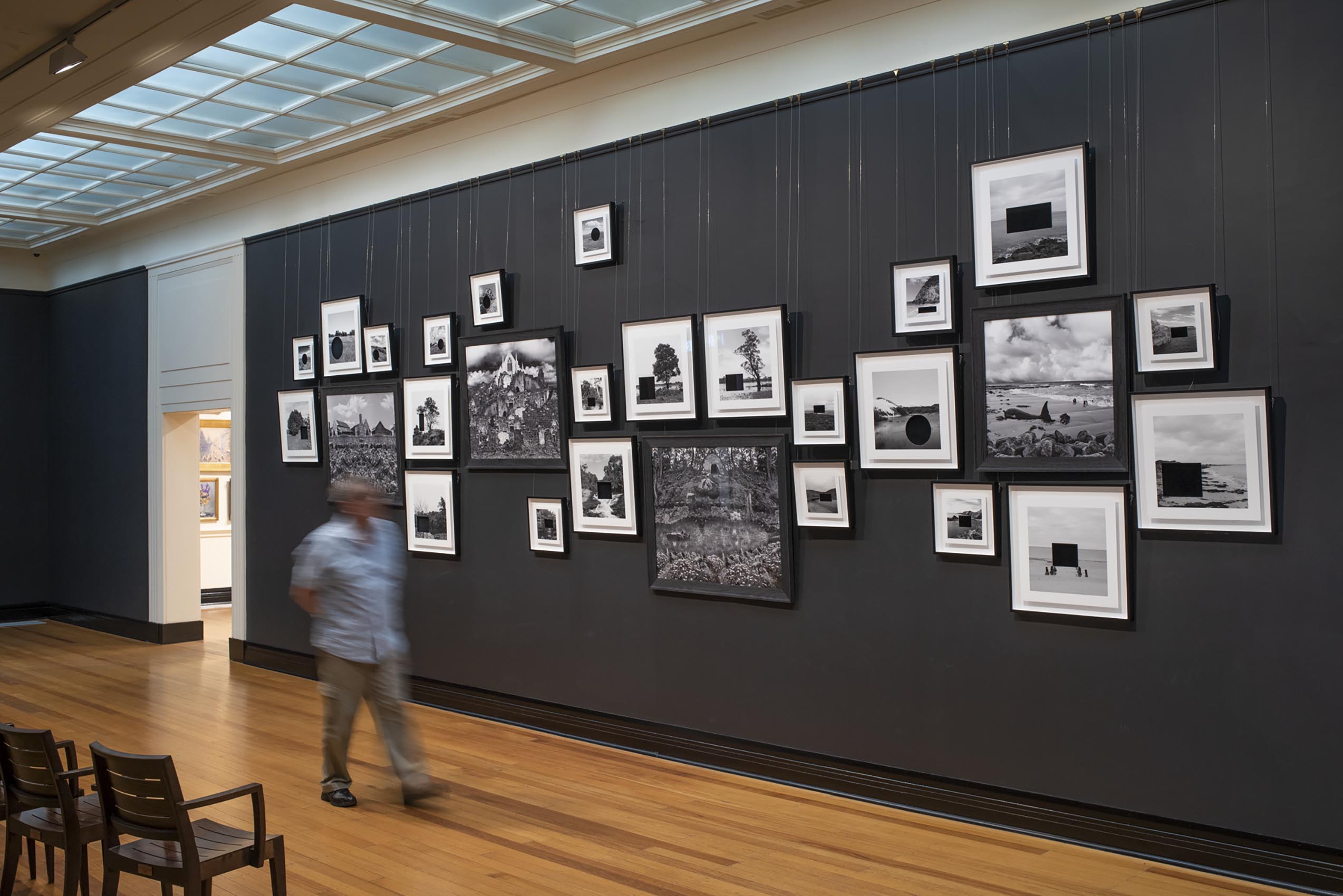
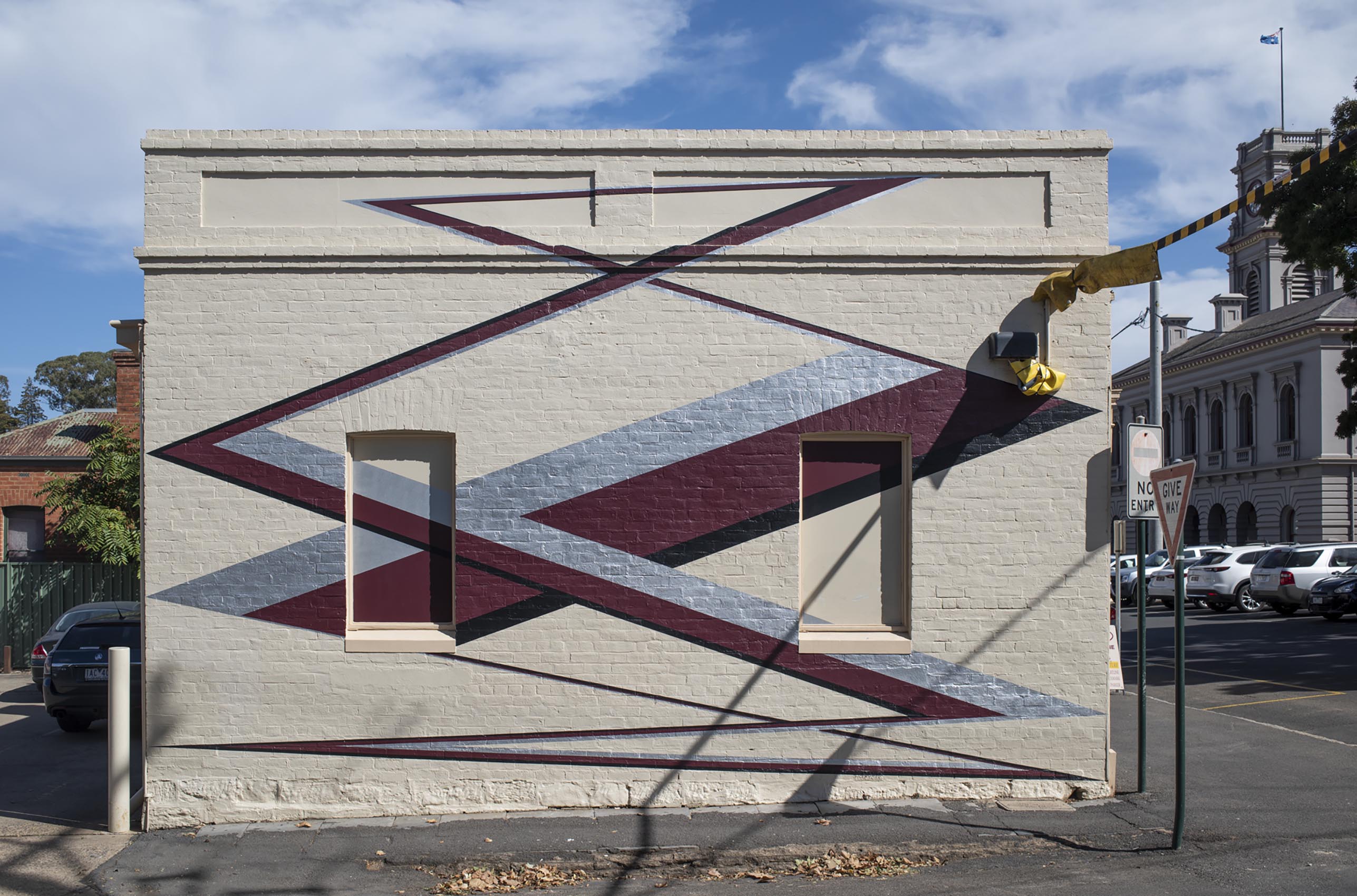
6 May – 22 June 2019
Curated by Glenn Iseger-Pilkington and Travis Curtin
Artists:
Damien Shen, Dean Cross, Gunybi Ganambarr, Illiam Nargoodah, James Tylor, John Prince Siddon, Ngarralja Tommy May, Noŋgirrŋa Marawili, Nyurpaya Kaika Burton, Patrina Munuŋgurr, Sharyn Egan, Sonia Kurarra, Wukun Wanambi.
unbranded presents work by Indigenous contemporary artists whose practices undermine and subvert the notion of a singular Indigenous ‘brand’ or ‘aesthetic’. Their work unpicks preconceptions of what Indigenous creative practice is or, should be, rejecting binary assumptions around ‘traditional/non-traditional’, or ‘urban/remote’ practices and other applied, and often arbitrary categorisations. unbranded as a curatorial enterprise questions these reductive and divisive modes of representation and interpretation, while affirming the diversity of contemporary Indigenous experience, both live and inherited. unbranded reflects the multiplicity, complexity and sometimes-conflicting experiences of culture and identity in contemporary Australia.
Image 1: unbranded installation view, La Trobe Art Institute, 2019. Artwork (left to right): Noŋgirrŋa Marawili, Wukun Wanambi, John Prince Siddon, Illiam Nargoodah, Gunybi Ganambarr. Photo: Ian Hill.
Image 2: unbranded installation view, La Trobe Art Institute, 2019. Artwork: James Tylor. Photo: Ian Hill.
Image 3: unbranded installation view, La Trobe Art Institute, 2019. Artwork (left to right): Illiam Nargoodah, Gunybi Ganambarr. Photo: Ian Hill.
Image 4: unbranded installation view, La Trobe Art Institute, 2019. Artwork: Dean Cross. Photo: Ian Hill.
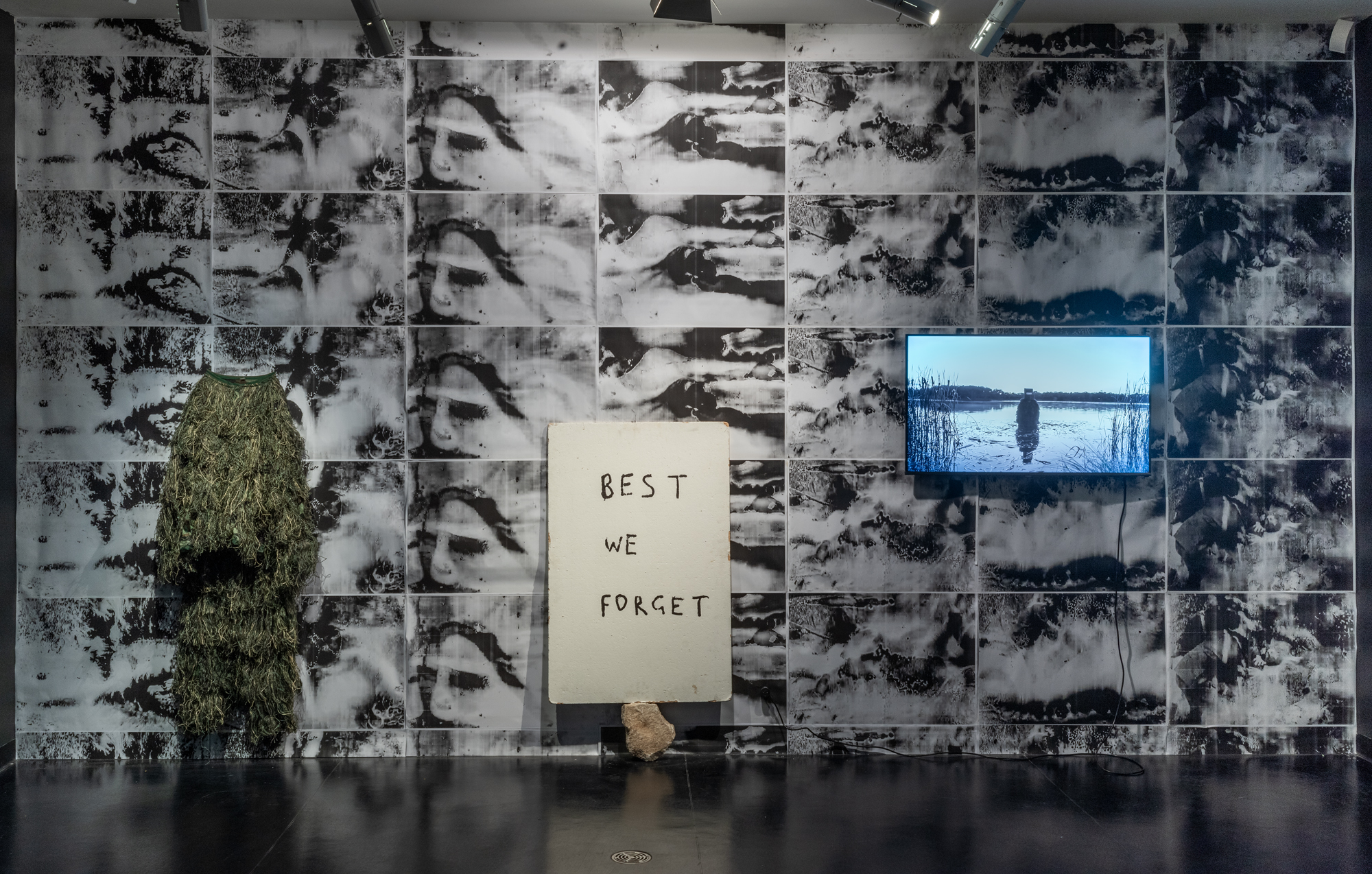

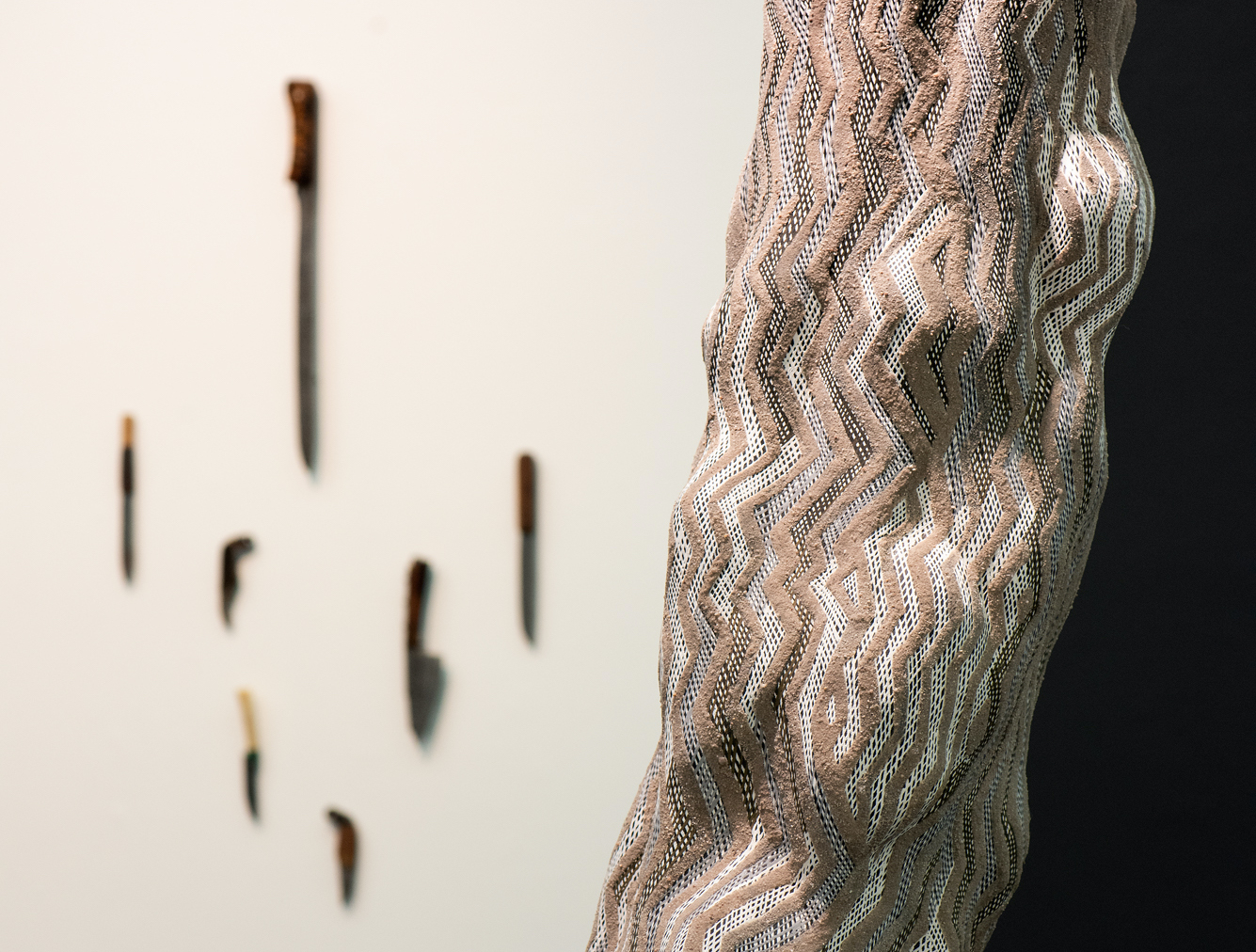
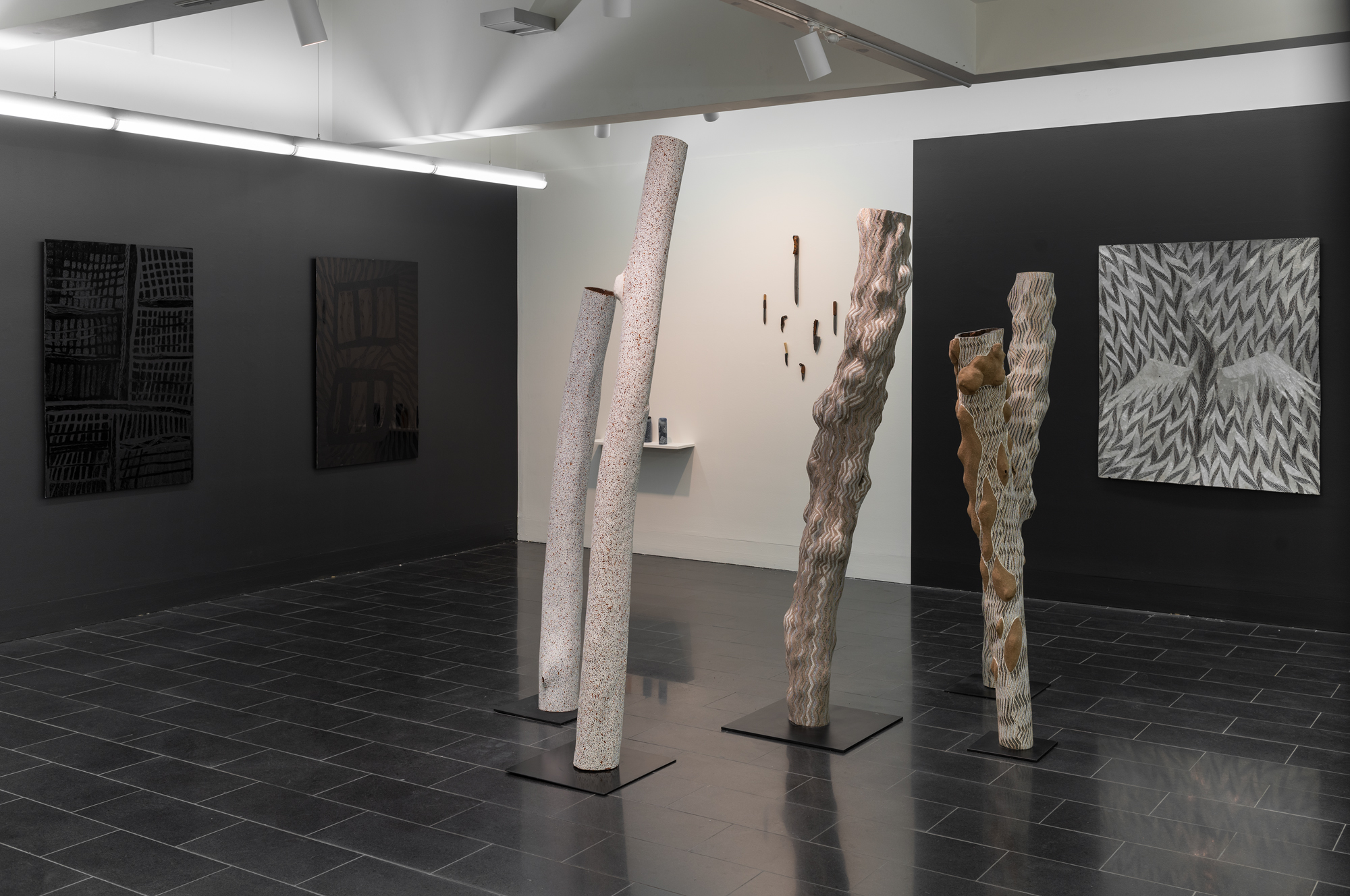
8 July – 24 August 2019
Artists: Brendan Van Hek, Rebecca Bauman, Ross Manning
Autoluminescent presents artwork by three Australian contemporary artists who work across a variety of media, yet all embrace luminescent materiality in aspects of their work, to explore the nature of visual perception, light-induced sensory experience, temporality, transformation and interplay between minimalism and monumentalism.
Autoluminescence refers to ‘the luminescence of a substance due to energy originating within itself’ and as such, the exhibition presents a range of luminescent works that generate light or draw on available ambient light, transforming it through processes of reflection, refraction and absorption, harnessing the power of light to produce ephemeral sensory works of art to be experienced in-place.
Image 1: Autoluminescent installation view, La Trobe Art Institute, 2019. Artwork: Rebecca Baumann. Photo: Ian Hill.
Image 2: Autoluminescent installation view, La Trobe Art Institute, 2019. Artwork: Ross Manning. Photo: Ian Hill.
Image 3: Autoluminescent installation view, La Trobe Art Institute, 2019. Artwork: Rebecca Baumann. Photo: Ian Hill.
Image 4: Autoluminescent installation view, La Trobe Art Institute, 2019. Artwork: Brendan Van Hek. Photo: Ian Hill.
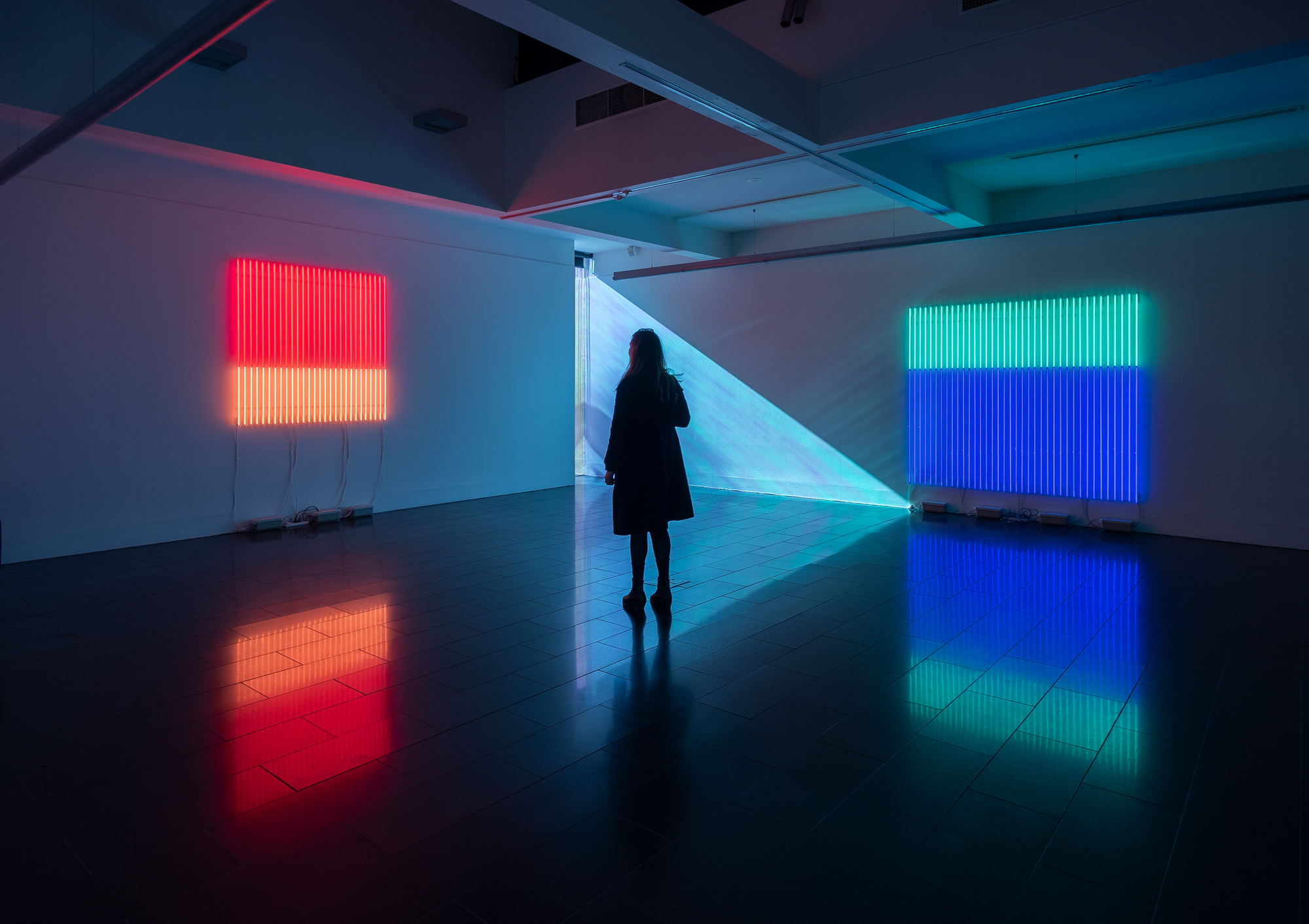

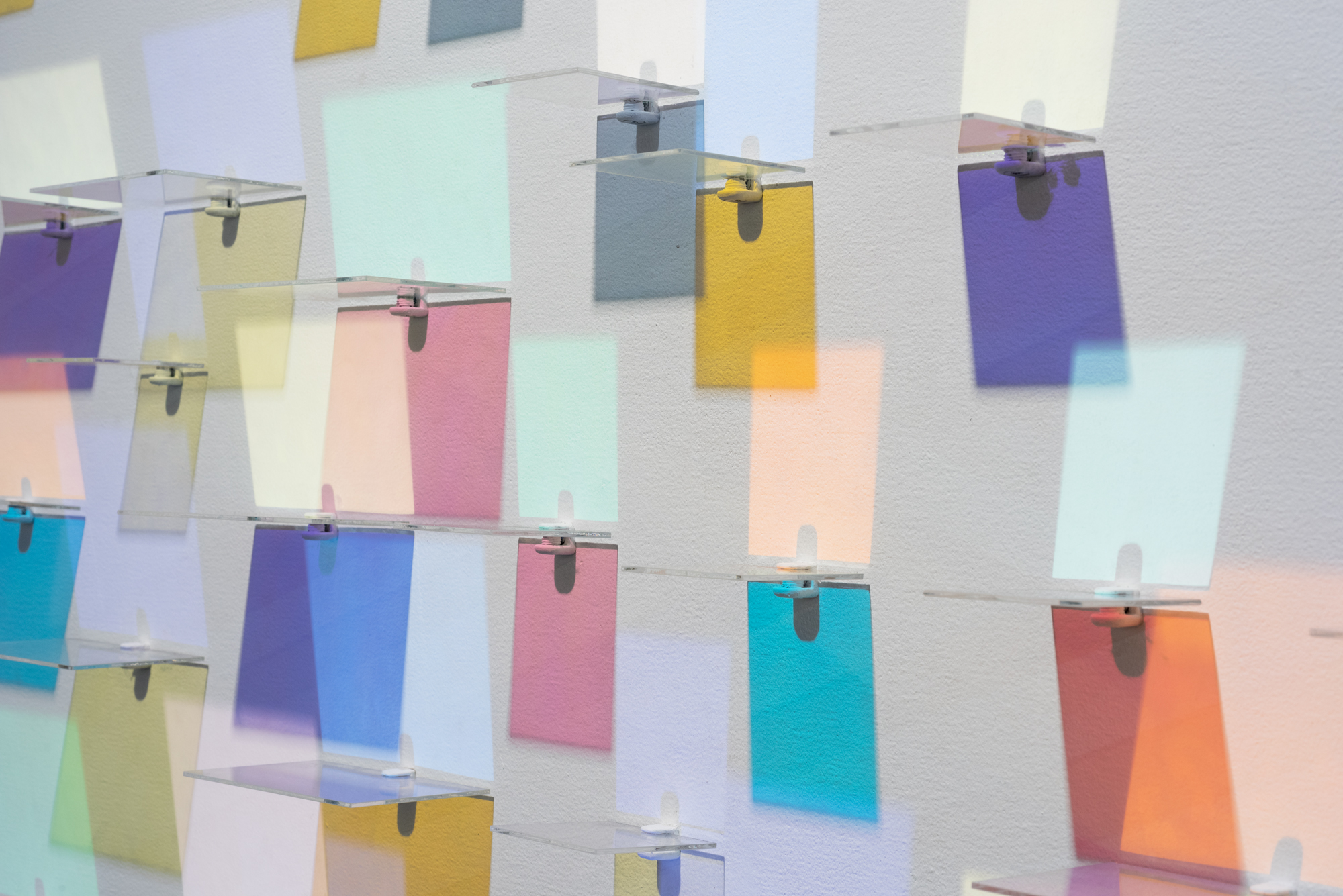
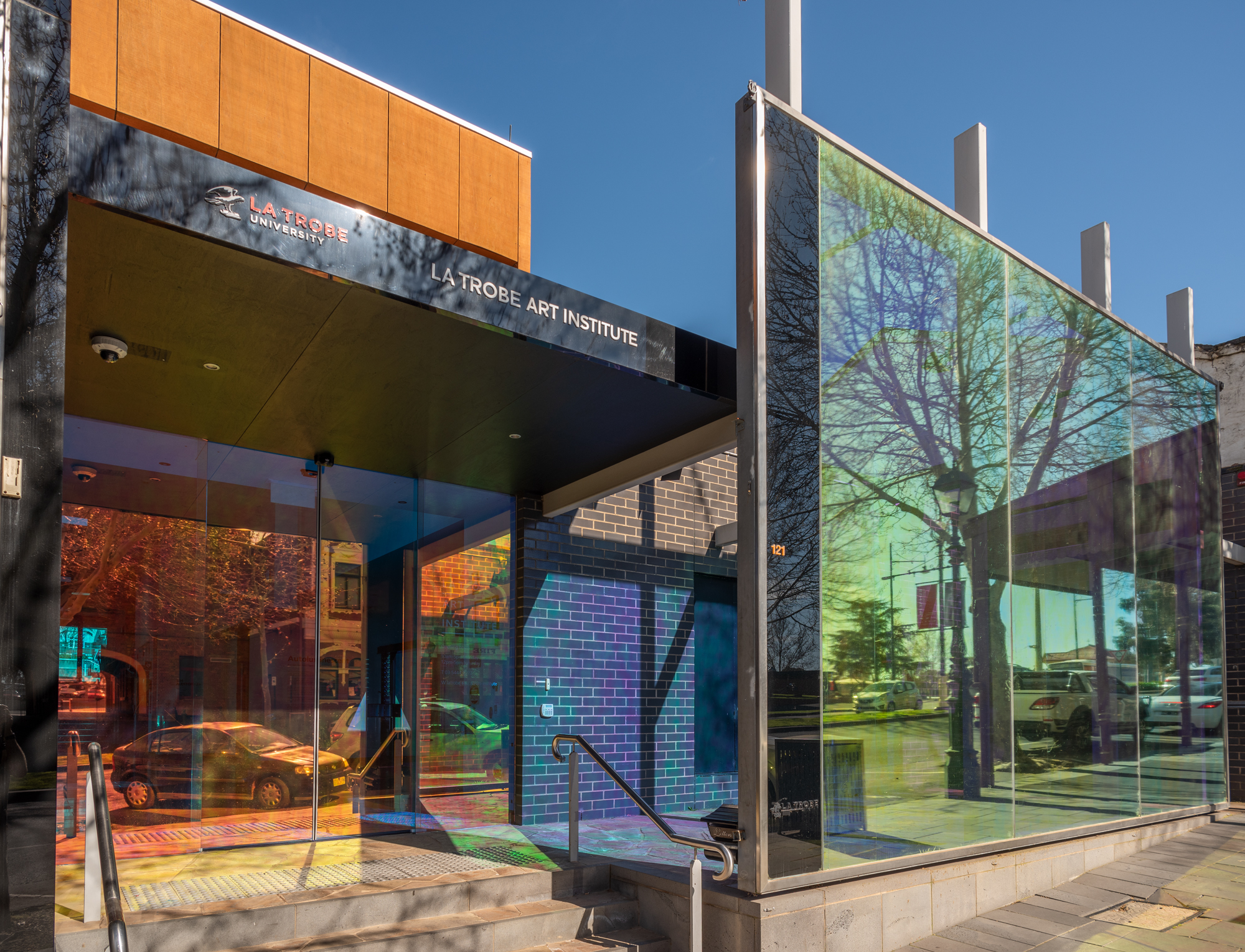
9 September – 22 October 2019
Presented by the La Trobe Art Institute and Multicultural Arts Victoria, Bendigo Emerge Cultural Hub, Interwoven is a cross-cultural and trans-generational weaving collaboration. Part workspace, part exhibition, Interwoven brings people from diverse backgrounds together through the process of weaving. The project celebrates the work of the artist in the context of an overarching thematic framework that draws from research into the creative practices of the weavers included in the project.
The idea of Interwoven is as much about the techniques, knowledge and materials of weaving, as it is about encouraging people to pick up and weave threads of conversation, exchanging ideas between cultures and generations.
Master weavers: Aunty Marilyne Nicholls, Regina Pilawuk Wilson, Ilka White, Bendigo Emerge Cultural Hub
Image 1: Interwoven, La Trobe Art Institute, 2019.
Image 2: Interwoven, La Trobe Art Institute, 2019. Detail Artwork Regina Pilawuk Wilson. Photo: Ian Hill
Image 3: Interwoven, La Trobe Art Institute, 2019. Artwork: Regina Pilawuk Wilson.Photo: Ian Hill
Image 4: Interwoven, La Trobe Art Institute, 2019.
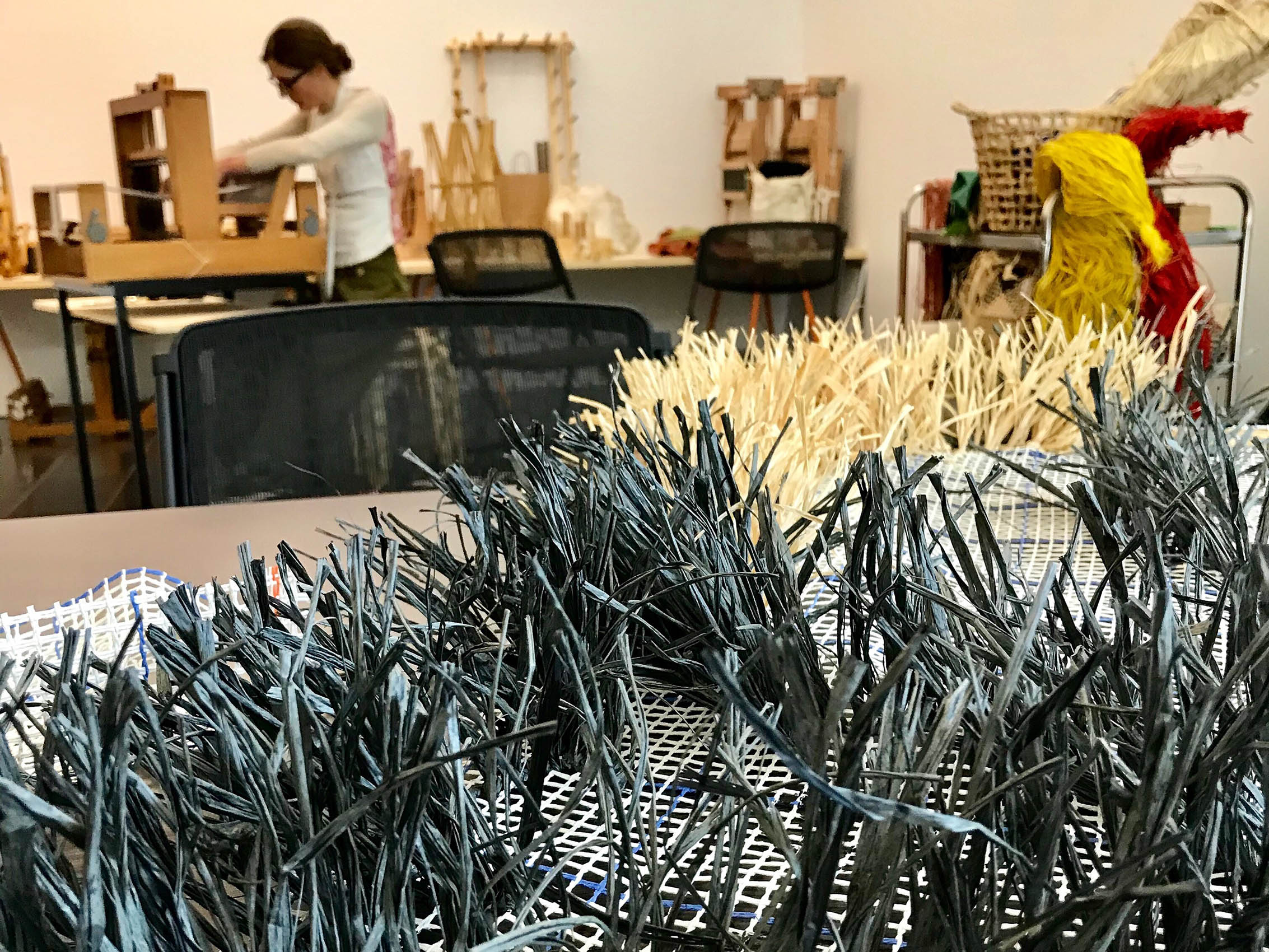
11 November – 22 December 2019
Tess Laird, Andrew Goodman, Erin Manning, Brian Massumi, Chris Cotrell, Lea Ehret, Come Ledsert, Anouk Hoogendoorn, Alexis Milonopoulis, Ernesto Filho, Indira Shanahan, Renske Maria van Dam
Based in Montreal, the SenseLab is an international network of artists and academics, writers and makers, from a wide diversity of fields, working together at the crossroads of philosophy, art, and activism.
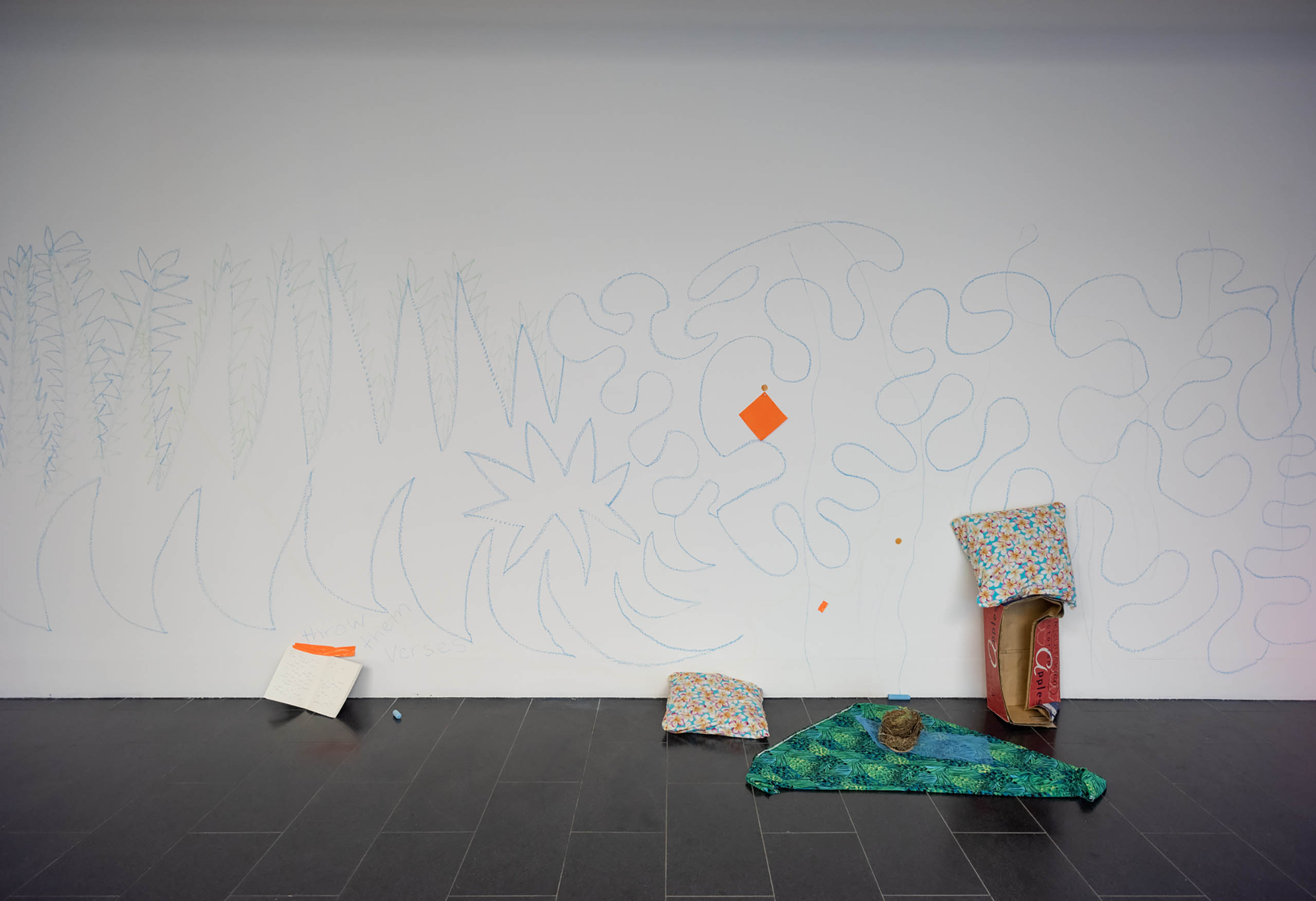
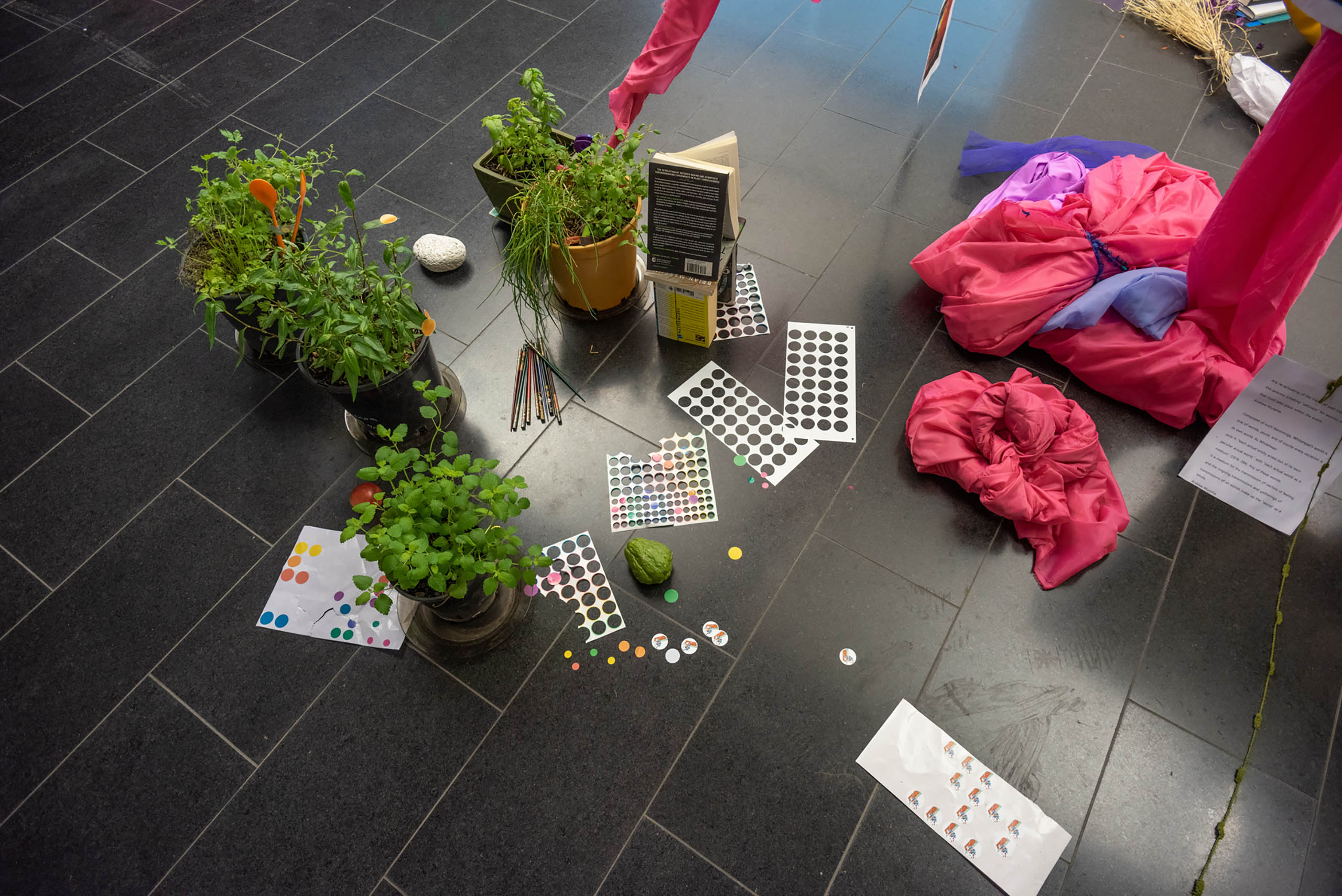
Installation images by Ian Hill, 2019
11 November - 22 December 2019
Janet Bromley, David Keating, Judith Warnest
Release and Clutch introduces three artists' simultaneous letting go and refined control through their own unique material approaches to shared gestural, poetic and improvised artistic activity. This exhibition builds connections between seemingly disparate practices to investigate aesthetic and conceptual relationships through a series of buoyant gestural approaches. Architecture and design inform elements of these artist's works as they make moves to guide yet free human experience.
All artists in this exhibition are currently undertaking Masters research in visual arts at La Trobe University.
Install view 1: Release and Clutch installation view, La Trobe Art Institute, 2019. Artwork: Janet Bromley. Photo: Ian Hill.
Install view 2: Release and Clutch installation view, La Trobe Art Institute, 2019. Artwork: Judith Warnest. Photo: Ian Hill.
Install view 3: Release and Clutch installation view, La Trobe Art Institute, 2019. Artwork: David Keating. Photo: Ian Hill.
Install view 4: Release and Clutch installation view, La Trobe Art Institute, 2019. Artwork: Janet Bromley. Photo: Ian Hill.
